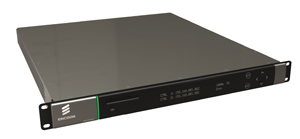PBS NGIS Adopts MPEG-4

ARLINGTON, VA.—The decade-long buildout of the Next Generation Interconnection System at PBS was on track to mark its latest milestone Sept. 17 when the public network converted the totality of its satellite distribution equipment from MPEG-2 to MPEG-4. The overall NGIS project is projected to be fully completed by late 2016.
“The primary goal of NGIS is to take ‘public television interconnection’ to the next level,” said PBS Chief Technology Officer John McCoskey. “That included a significant technology refresh and an architecture that would drive both efficiency and flexibility over a 10-year period that encompasses multiple elements and technology cycles.”
Remember that NGIS was conceived in the era of tape-based origination analog TV and standard definition, and so it needed to take us through the digital transition, [including] file-based workflows and high definition,” McCoskey said.
CARRIER ID
Stefan Petrat, vice president of Distribution Operations & Engineering at PBS, is leading the NGIS initiative from the network’s Arlington, Va. headquarters. “An important part of the MPEG-4 upgrade is the support of Carrier ID in the Ericsson 8190 encoders and Newtec M6100 modulators,” Petrat said. “Carrier ID is a ‘stamp’ on uplink signals that will enable satellite operators to identify transmissions to their satellites and coordinate with earthstation operators in the event of signal interference.” PBS is supporting the World Broadcasting Unions-International Satellite Operations Group and others to promote global Carrier ID standardization.

Al Nunez Al Nunez, president/Americas at Ericsson Television, said since radio frequency interference negatively impacts qualityof- service for broadcasters, operators and at-home consumers, Ericsson has been working with PBS and other industry leaders in the development of Carrier ID. “Using this identification method allows satellite operators to identify and quickly contact the source of interference, which directly affects and can increase qualityof- service by providing faster resolution to signal disruptions,” Nunez said. “Switching to MPEG-4 enables PBS to deliver more content with higher video and audio quality, using the same bandwidth limitations. And any bandwidth savings could enable PBS to add new services.”
Nunez said deployment of more than 1,500 Integrated Receiver Decoders to PBS stations was a highly coordinated event: “Each RX8200 IRD was shipped from the factory to Duluth, [Ga.], where [each unit] was loaded with the specific PBS configuration—and then thoroughly tested by running them for 24 hours. Presetting and pre-soaking the receivers before they’re put into the field provides a more reliable deployment,” Nunez said. (Ericsson’s MPEG-4 distribution system also has been tapped by ABC/ESPN, NBC Universal, Telemundo and Univision, among others.)
As for public TV viewers, Petrat said “they can clearly see and hear the significant technical quality improvements of MPEG-4. NGIS allowed us to create a state-of-the-art playout and distribution system, enabling stations to pass on superior quality images and sound to consumers.” Nunez said for viewers with largescreen HD sets, “the visual resolution may be dramatically improved and images will have less compression artifacts. The side-by-side comparisons of programs compressed in MPEG-4 and MPEG-2 are impressive. It doesn’t take a golden eye to see MPEG 4 delivers higher quality at lower bit rates.”
The professional video industry's #1 source for news, trends and product and tech information. Sign up below.
NRT ROLLOUT UNDERWAY

PBS shipped more than 1,500 Ericsson RX8200 IRDs to member stations. Petrat said the NGIS also centers on Ku-band satellite transponder-leasing and a wide variety of sub-projects—such as Non-Real Time, a file-based delivery system to stations via satellite. He said NRT has been rolled out to more than 70 percent of local PTV outlets, with the remaining ops sites scheduled to receive NRT equipment by late 2012.

John McCoskey “NRT is an efficient way to deliver content that can be recorded, stored and played at a later date,” Petrat said. “It leverages an IP-based system to transmit programs as an AS03 MXF-wrapped file by satellite to ‘catchservers’ at stations, instead of sending the content in baseband as real-time program feeds that need to be physically recorded by a video server or tape deck. NRT delivery reduces the number of encode cycles, thus reducing concatenation artifacts. This catch-server communicates with a station’s traffic system and playout server to push content to air,” Petrat said. Each catch-server has 12 terabytes of storage (typically enough for about 10 days of content).
CTO McCoskey said a key advantage to NRT distribution is “it eliminates the manual step of trimming the beginning and end of a recorded program that station personnel would normally have to do. That may seem like a small thing, but multiplied by hundreds of stations and thousands of shows each year, the labor reduction across the system is significant. NGIS is designed to increase workflow efficiency,” he said.
The last major project on the current NGIS agenda is a broadcast disaster recovery facility. The goal of DDMS (Disaster Recovery, Diversity and Maintenance Site) is to construct a replicated backup of the PBS Tech Center in Northern Virginia at PTV’s Nebraska Educational Telecommunications facilities in Lincoln. McCoskey said the DDMS will be a standalone “lights-out” operation built on an all-IP platform remotely—and monitored and controlled by PBS staffers in Virginia. DDMS is scheduled for completion by the end of this year.
